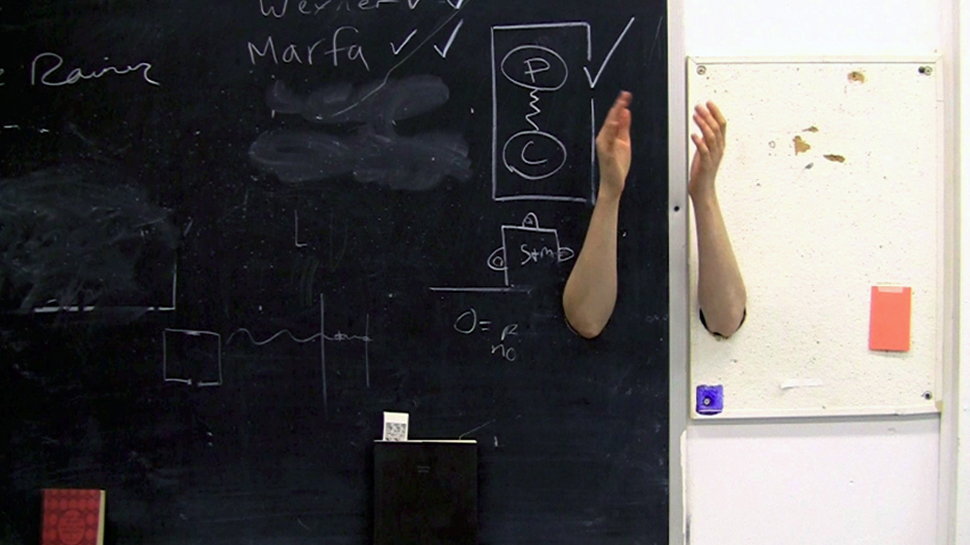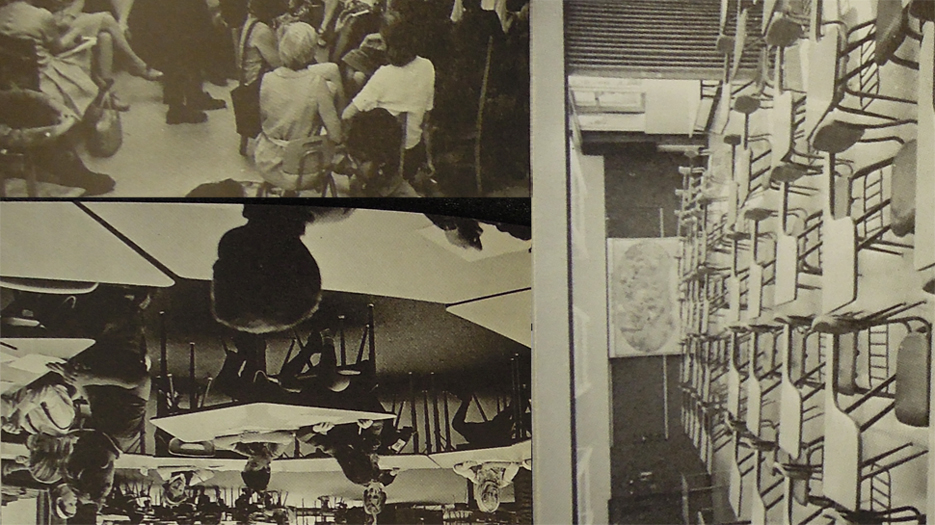A Partial Re-enactment
In December 2011, while a graduate student in Chicago, I was invited to participate in a response evening for an exhibition titled and then a pause. The exhibition contained works by students in an interdisciplinary writing course offered by the Writing Program Department at the School of the Art Institute of Chicago. The evening consisted of some installations and short performances each responding to a work in the exhibition. I chose Wailing by Michaela Murphy, an area of white wall that silently and almost imperceptibly shed perpetual tears through two invisible, pinholes. After removing my coat, shoes, and socks, I stood before the audience, doing nothing for five minutes except making eye contact with many people as possible.
My performance was a response to Micheala’s wall, a farewell to Chicago, which I would be leaving days later, and also a re-enactment of a work I had heard about from a friend but never seen or studied by Japanese artist Seiji Shimoda. I did not do an exact re-enactment of Shimoda’s performance, more what I’d describe as a partial re-enactment.
Re-enactment and Reinvention
I was reminded of my partial re-enactment on Saturday night when I attended Milena Tomic’s lecture and discussion, “Place-Specificity and Global Fantasy: New Modalities of Reinvention”, which was presented as the first of the Saturday Evening Open Studios that are part of Back To School, Vesna Krstich’s curatorial residency at TPW. Tomic spoke about Allan Kaprow’s Happenings and Environments and various iterations of them that have been created before and since his death both by him and by other artists. She described two types of iterations: “As Kaprow’s preferred term, ‘reinvention’ was a reinterpretation of a given score or set of instructions. In contrast, ‘re-enactment’ implied a mere copy of the first iteration.”
Newer reinventions, such as the ones Tomic showed us from A Fantasy for Allan Kaprow, a 2009 exhibition in Cairo, depart so thoroughly from the initial score or instructions that they no longer seem to fit Kaprow’s definition of “reinvention.” The contexts and identities of the artists who created them differ so intensely from Kaprow’s that reinventions as per Kaprow’s specifications are perhaps not even possible. Tomic asks, “To what degree can reinvention differentiate itself form the historical work before the connection between them is obliterated?” I assume that to those artists who exhibited in Cairo, the link to Kaprow’s work has never been obliterated although it may appear to be to those of us viewing their reinventions from the outside. They are indelibly connected to Kaprow’s work even if their reinventions highlight all of the ways they are distinct from his work.
Reinvention and Knowing
I was going to write that my own experience of reinterpreting a work of art, which seems to fit somewhere between re-enactment and reinvention as they are described above, brought me to a greater level of intimacy with the original work by Shimoda; but I cannot definitively say that I know more facts about Shimoda’s performance—exactly what he did and how he did it, the origins of the work, or what he felt—after having presented my own version of it. Yet, I do feel closer to Shimoda’s performance. I learned many new questions and also possibilities of what he might have felt and what decisions he might have had to make. For example, only in imagining myself in the re-enactment did I begin to wonder what governed Shimoda’s decision about who to make eye contact with next, having stared at one person for a length of time.
Krstich’s curatorial residency is also a reinvention—a pedagogy- and art-inspired investigation into Project Other Ways, Kaprow and Herbert Kohl’s storefront alternative educational experiment of the late 1960s. Project Other Ways is a mysterious project with no documentation of the space it operated out of and no writing attached to it (aside from some of the instructional materials they used). Many of the texts, photographs, and films that must have existed as part of the project are now lost or hidden.
I have no idea if Krstich’s Back to School will help us understand Kaprow and Kohl’s endeavour with greater clarity and detail. I do think it will crystalize a set of questions—it will help us understand what we do not know about Project Other Ways and how our context differs from that of 1960s Berkeley, California.
Re-enactment as a pedagogical act
Since that moment in Chicago towards the end of 2011, I have thought of re-enactment as a pedagogical act. Engaging in a material way in space, using the body or not, with someone else’s work of art is an educational experience, just as reading, thinking, and writing about it is. I hesitate to make the comparison to copying the paintings, drawings, and sculptures of masters—an old tradition of art education—because I think of re-enactment as more contemporary and dynamic, and more intellectually and creatively immersive than that. Yet, there is something transformative and incredible about both.
It makes sense to me that Krstich chose to explore Project Other Ways through reinvention, a mode that interested Kaprow and that I believe is connected to teaching and learning, and becoming closer to a work of art.










